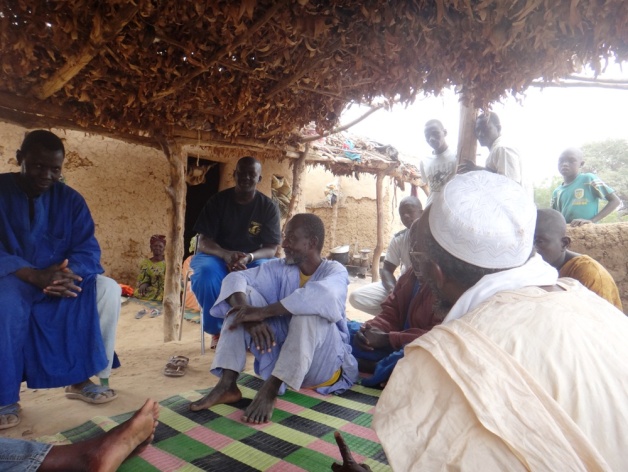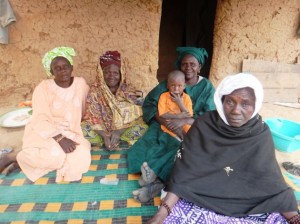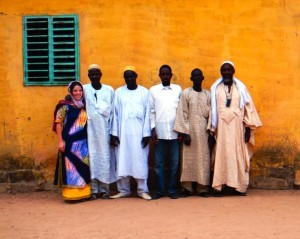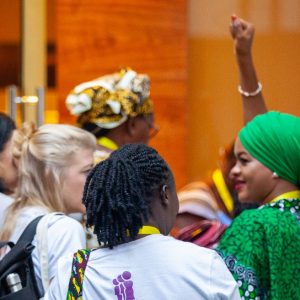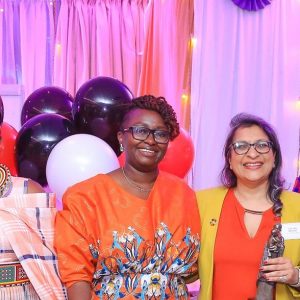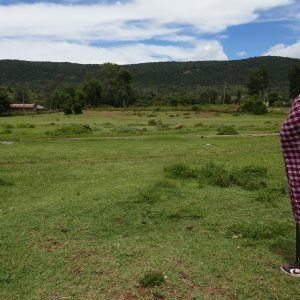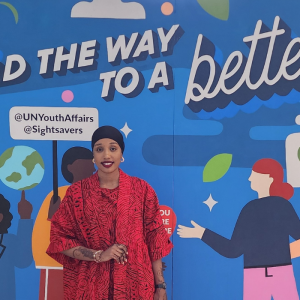Visiting the village of Hounouko Aéré
On Thursday morning, we packed up our bags, gave our thanks to our wonderful hosts in Aéré Lao and hailed a horse-drawn cart. We were on our way to visit Hounouko Aéré, a small village of less than 500 people about 6km from Aéré Lao. If they were welcoming and had the space, we would spend the night out there. If not, we would return to Aéré Lao later that evening.
After a long hot dusty ride, we finally arrived in Hounouko Aéré. We asked after the village chief, Mamoudou Maar, and were directed to his family compound. We were led to a shaded area at the back of his compound where we sat on mats in front of the village chief with a few community members looking on.
Abdarahmane Ba and Abdoul Samba Sow once again were the first to speak on behalf of the Tostan team. They with Samba Diallo and Saidou Kane spoke with the village chief about the movement to abandon FGC and its importance for girls’ health and rights. The village chief however was very hesitant to offer his support without permission from the local authorities – either the president of the rural community or the sous-préfet.
I could feel some tension. No one was smiling. Few of the community members were speaking up. However, the team members were quick to turn the meeting around, and so even though we wouldn’t be able to return tomorrow, the team could return during another tour. After promises of talking to the local authorities and a promise to return at a later date, we were eventually invited to stay for lunch.
When we arrived in Aéré Lao, we took advantage of the extra night in town to visit the local Community Management Committee (CMC) in the neighborhood of Médina Baye on the outskirts of Aéré Lao. The CMC was established when Tostan’s Community Empowerment Program (CEP) classes began in the community of Médina Baye. Still extremely active in their neighborhood, they are an important partner for the social mobilization team in reaching other neighborhoods in Aéré Lao that have not gone through the CEP.
A trip out to Koylel
On Friday, we once again were in for a long cart ride. This time we were going to visit Koylel, another village in the area of about 300 people. Traveling once again from Aéré Lao and out into the surrounding villages, I felt how wide and vast the Fouta can be. We passed only one or two small villages as we traveled through fields, around rock quarries, and across the dry desert landscape. There was no one else to be seen except for a few herders with their cattle or sheep.
Samba Diallo prepared me for potentially another meeting like yesterday. Koylel and Hounoukou Aéré are villages from the same ethnic group and social network, closely related through familial ties. It is possible that since Hounoukou Aéré was not willing to talk to us without permission from the local authorities that Koylel would have the same reaction. Once we arrived in Koylel, even though the village chief was not available, we were readily welcomed to meet with the local men of the village.
Once again, Abdarahmane opened the meeting with a prayer. Samba Diallo then presented the team and our efforts to reach out to communities around FGC abandonment. The community members present were open to talking, although any official decisions would have to wait for another meeting with the village chief. As Abdoul Rahman talked about the health risks associated with FGC, the community members nodded their heads in agreement and mentioned how they had seen the same before. As Seydou talked about the National Action Plan for Total FGC Abandonment by 2015, they passed around the Pulaar translation of the 1999 law prohibiting FGC.
As the meeting concluded, we met the women who had slowly gathered to listen and were accompanied down the hill by the men. Each team member was in deep conversation with one or two community members, continuing to discuss the issue of FGC and child/forced marriage even as we were trying to negotiate our cart ride back to Aéré Lao.
A successful effort
After every visit, I would always ask how the team members thought that it went. The answer was always “weli”, meaning pleasant in Pulaar. Even the visit to Hounoukou Aéré was “weli” despite the fact that we weren’t invited to come the second day as originally planned. I learned that any visit, no matter the reaction, is a good visit. It opens up minds. It starts discussions at home and in the community after the team leaves. Each visit is a step towards positive social change.
After visiting six villages in nine days, the team members were each looking forward to heading home. And yet, as we were all walking to the main road to catch our respective rides, they were talking about what they wanted to accomplish next month. They talked about villages to revisit, new villages to reach out to, and local authorities to get involved.
Story by Elke Schmidt
This blog is part of a series on the Social Mobilisation project that Orchid Project funds in support of Tostan’s long term Community Empowerment Programme. Social Mobilisation is focused on ensuring the acceleration of abandonment of FGC in Senegal. Teams of volunteers who have already abandoned FGC, called social mobilisation agents, visit and create dialogue with inter-connected communities on human rights and the negative consequences of FGC. Their work aims to spread the message of abandonment and encourage others to join them.
Social mobilisation agents are individual members of the community who have been inspired by their understanding that FGC is a harmful practices, and are eager to share their own experiences with others. Often, they are religious, traditional or community leaders who are widely respected and well-connected, active, influential participants.
You can find out more about Social Mobilisation by clicking here. If you would like to support this work, please click here.

